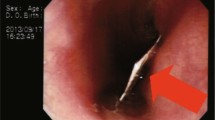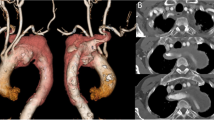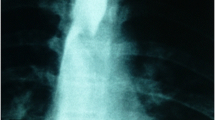Abstract
A patient had massive hematemesis due to a fistula between an unsuspected aberrant right subclavian artery and the esophagus, with the fistula caused by prolonged esophageal intubation. Lack of awareness of this complication delayed the correct diagnosis, which was eventually made at a second angiographic study. With knowledge of the fistula, this potentially fatal situation can be promptly diagnosed by endoscopy and emergency angiography. Transcatheter embolization is suggested as a potential alternative to surgery in the treatment of the aberrant right subclavian artery-esophageal fistula.
Similar content being viewed by others
References
Stewart JR, Kincaid OW, Edwards JE (1964) An atlas of vascular rings and related malformations of the aortic arch system. Charles C Thomas Publisher, Springfield, Illinois, p 53
Molz G, Burri B (1978) Aberrant subclavian artery (arteria lusoria): Sex differences in the prevalence of various forms of the malformation. Virchows Arch [Pathol Anat] 380:303–315
Siderys H (1969) A new operation for symptomatic aberrant right subclavian artery in the adult (dysphagia lusoria). J Thorac Cardiovasc Surg 57:269–272
Dotzauer G, Althoff H (1966) Pathologische Befunde nach Tracheotomie. Z Anästh Wiedblbg 1:297–305
Wienberger G, Randall PA, Parker FB, Kieffer SA (1977) Involvement of an aberrant right subclavian artery in dissection of the thoracic aorta: Diagnostic and therapeutic implications. AJR 129:653–655
Merchant FJ, Nichols RL, Bombeck CT (1977) Unusual complication of nasogastric esophageal intubation—erosion into an aberrant right subclavian artery. J Cardiovasc Surg 18:147–150
Felson B, Cohen S, Courter SR, McGuire J (1950) Anomalous right subclavian artery. Radiology 54:340–349
Wholey MH, Stockdale R, Hung TK (1970) A percutaneous balloon catheter for the immediate control of hemorrhage. Radiology 95:65–71
Gianturco C, Anderson JH, Wallace S (1975) Mechanical devices for arterial occlusion. AJR 124:428–435
Castaneda-Zuniga WR, Galliani CA, Rysavy J, Kotula F, Amplatz K (1981) “Spiderlon”: New device for simple, fast arterial and venous occlusion. AJR 136:627–628
White RI, Barth KH, Kaufman SL, DeCaprio V, Strandberg JD (1980) Therapeutic embolization with detachable balloons. Cardiovasc Intervent Radiol 3:229–241
Author information
Authors and Affiliations
Rights and permissions
About this article
Cite this article
Belkin, R.I., Keller, F.S., Everts, E.C. et al. Aberrant right subclavian artery-esophageal fistula: A cause of overwhelming upper gastrointestinal hemorrhage. Cardiovasc Intervent Radiol 7, 87–89 (1984). https://doi.org/10.1007/BF02552686
Issue Date:
DOI: https://doi.org/10.1007/BF02552686




